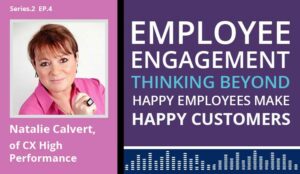Michael Allen looks at the 5 core principles which could help you to improve employee engagement in your contact centre.
1. Have a inclusive approach to cultural development
Choose a culture. Be deliberate and be inclusive.
Your staff are adults. They are worldly-wise, have mortgages, children and responsibilities. When developing an employee engagement and cultural development programme, be mindful of this.
A mature approach can help create meaningful dialogue and dive deeper into the tougher issues.
One organisation running a highly evolved company culture is Moneypenny. It is interesting how they discuss culture with staff at all levels. Take a look at their website and you will see really detailed pieces about the culture of other companies, what other companies stand for in terms of culture.
It quickly becomes clear that discussion of culture development is a significant concept in everyday life at Moneypenny. In addition, everyone is a stakeholder.
The emphasis is on evolving a culture that everyone gets, likes and buys into for the evolution and success of individuals, customers and the business.
2. Let team members take the glory
Pictures of contact centre leaders brandishing a trophy, surrounded by half a dozen team leaders, doesn’t fit a progressive employee engagement culture. We’ve all seen it, and let’s face it, it’s not so pretty.
Real leaders stand back; they let their team members take the glory.
I am always greatly impressed by Irish customer service leaders at the CCMAI Awards in Dublin. They have developed a widespread practice of taking the back seat when awards are given. Modest, unassuming and empowering to their front-line staff.
Seeing a contact centre manager taking a trophy and enjoying the photoshoot just seems a little out of balance with modern engagement thinking. Why not empower a person who has gone “above and beyond” the call of duty to have a moment or two of praise?
3. Liven up your employee engagement feedback
It’s time to drop the tired old annual employee engagement survey altogether. We are in the media age, most of your staff are millennials. Brighten things up. Dump the structured questionnaire.
A couple of years ago, I had a call from TNT. The call was asking how they could get feedback from staff without a boring questionnaire.
I was so grateful for that call because I didn’t have a solution. It really made me think.
For a while I asked front-line staff in lots of organisations what they thought of their annual employee engagement survey. The answers were as sobering as they were consistent – “boring”, “waste of time” and “no feedback given, so why bother?”.
That’s what people really think.
An annual exercise, based on a standard questionnaire. How absolutely boring is that for your people? Even if it is giving you some form of benchmarking, structured surveys are tired, tired, tired.
If you add in that the feedback is often not forthcoming, or sanitised in corporate speak, no wonder participation is so poor.
Take out a new broom, move away from structured questionnaires. Go for pop-quizzes, panels, discussion boards with the ability to attach documents, pictures and even videos.
But, most importantly, feedback your feedback! Feedback fast and feedback with integrity.
4. Put your money where it matters
People come to work to earn money to pay their bills. It is hard to be engaged if you don’t know how to cover your electricity bill, or put food in the cupboard.
Many of your people will be struggling. Perhaps they have debt, an unemployed partner, costs which they are struggling to carry.
You will have your salary levels, of course, but even if these are fixed you can do more.
Larger employers can show they care with hardship loans, small crisis loans or low-cost holiday facilities. If you work with a credit union, even smaller organisations can offer assistance.
Timpson are a family business with excellence in this area. They show true care by providing staff with a full final salary pension in reward for long service. They are swimming against the current practice, but engaging their people in a deep and meaningful way.
5. Blend staff and customers together in a single culture
This is an increasingly popular cultural plan. In fact, some organisations now say their people come before their customers!
This concept is working well at B2B space. Because they have fewer customers, the idea is more easily honed than in larger retail environments, but progress is being made in both areas.

Michael Allen
It is vital that negativity towards customers is driven out of the business and that this is made a cornerstone of culture.
Another great example of this business-blending culture is Fix Auto. If you pick up a copy of Infofix, the company’s monthly magazine, it drips with team work. It is actually difficult to distinguish between the business and franchisees – such is the power of engagement.
The Managing Director, Ian Pugh, has taken it even further by bringing in their main suppliers to an internal awards ceremony.
With thanks to Michael Allen, Founder of Business Yearbooks and seasoned contact centre observer.
Author: Megan Jones
Published On: 10th Feb 2016 - Last modified: 16th Aug 2022
Read more about - Hints and Tips, Editor's Picks, Employee Engagement, Feedback, Motivation, Reward and Recognition

















